Which project management trends will we see in areas such as resource planning, collaboration, methods and tools? How are the roles of the participants in the project environment going to change? And what new challenges are in store for the PMO?
In this article (updated in early 2024), we take a look ahead to the coming years in agile, traditional and hybrid project environments. The trends, however, do not apply to all industries and types of projects in the same way. We combine our own experience with the information from public sources and derive the main points from this. Based on assessments and forecasts, you will be able to implement the right strategies for your project management environment.
Our goal: you have peace of mind, knowing that you always have full control over your project environment.
These are the topics in store for you:
- Some relevant studies
- Trend 1: More artificial intelligence in project management
- Trend 2: PM tools and automated data use
- Trend 3: Communication is increasingly integrated into project plans
- Trend 4: Greater focus on the benefits of results
- Trend 5: Change management and transparency are becoming more important
- Trend 6: Resource planning is becoming more and more important
- Trend 7: The PMO is becoming more strategic
- Conclusion: Project management trends
Let us start with a look at a couple of studies relevant to the trends topic!
Some Relevant Studies
The world has changed significantly in the last few years – not least due to the COVID-19 pandemic, digitization or climate change. This also has an impact on our professional world.
This is how the German Handelsblatt headlined its article on the current STEM shortage in Germany (German: MINT) from November 23, 2022: “Germany has a shortage of around 326,000 STEM experts: despite the economic slowdown, the lack of technical and IT staff reaches a new all-time high. This threatens the current high innovative strength of companies”. A massive gap for the future presenting the world of work with new challenges. This trend continues even today.
This has an impact on the skills required of employees – the so-called future skills. The Stifterverband and McKinsey & Company published the “Future Skills Framework 2021” (German language). According to this source, it is possible to differentiate four categories:
- Traditional skills
- Key digital skills
- Technological skills
- Transformational skills
Above all, the respondents considered the skill of problem-solving ability important, as well as entrepreneurial behavior, initiative, resilience and creativity. And it is exactly these skills that will gain importance over the next few years according to the survey.
Key digital skills, such as digital collaboration and agile methods, are coming more and more into focus.
Yet, which project management trends can be derived from these developments? Let us get into our forecasts.
Trend 1: More Artificial Intelligence in Project Management
The AI wave was triggered by the chat bot ChatGPT at the end of 2022. At the end of 2023, Microsoft launched Microsoft Copilot. It will be rolled out gradually and is intended to serve as an assistant. It will support day-to-day work in the environment of Microsoft Office and other tools. The Copilot inspires and makes it possible to work more efficiently overall.
Microsoft Copilot will also be part of the New Planner, a combination of Project for the Web and Planner in a new guise. This New Planner has been announced by Microsoft for 2024.
Many tools now offer similar AI support. In project management tools (e.g., Planisware), the possibility to use AI based on one’s own planning data already exists. This is meant to contribute to improved planning and well-founded analyses without having one’s own data leave the company. Data protection in AI applications is one of the key topics for the near future.
With AI support, project plans will improve in the future – especially for inexperienced project managers. Based on one’s own project data from the past, this support represents active Lessons Learned in Project Management which help reduce errors.
So far, AI services are often free of charge. This is going to change, however, as their capabilities represent important competitive differentiators. With the really good tools, there will be a lot of money to be made in the future.
The graphic below shows the results of a poll in a German-language TPG webinar from January 2024 asking what the participants would like to see in AI support in project management.
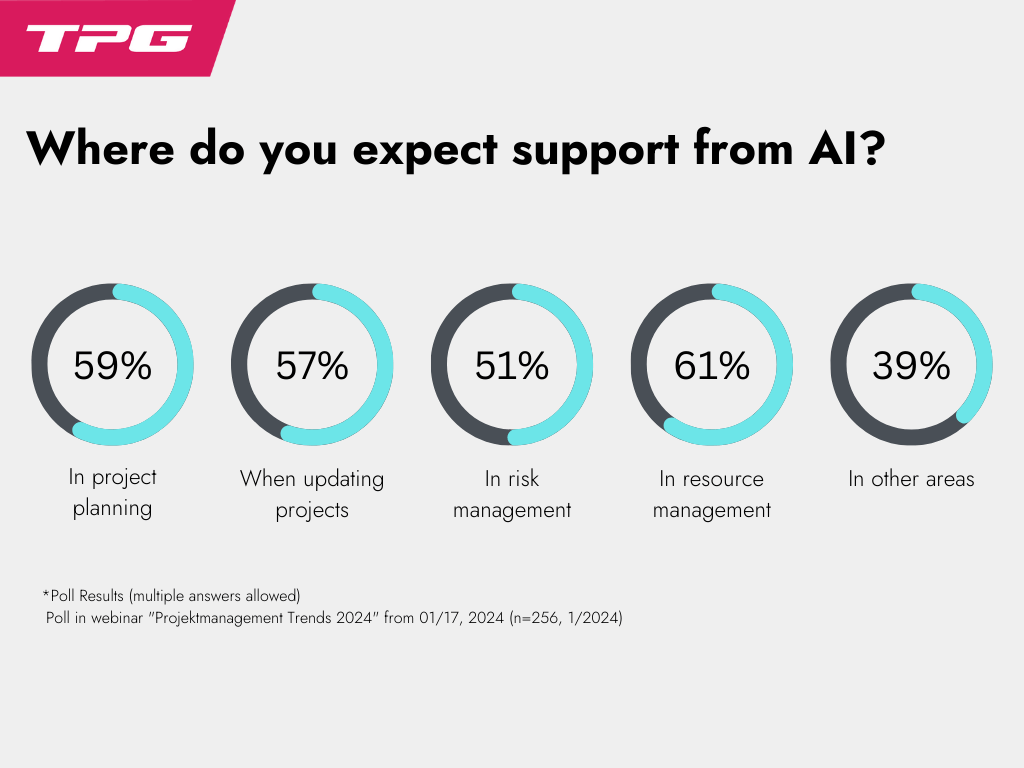
Tool manufacturers are currently developing AI support which will increasingly go beyond good reporting based on the existing project data. Additional information with additional value generated by AI already exists and will be available on a larger scale before long.
This will include AI-supported help with:
- Automatic resource leveling
- Automatic updates of the project plan
- Questions like “What would happen if this project task were shifted …”
Our tip: Play around with tools like Microsoft Copilot, ChatGPT or others. Learn how to benefit the most from the tools by making your questions more and more specific. At the same time, find out where the current limitations of the tool lie.
Trend 2: PM Tools and Automated Data Use
It is already much easier than before to begin using PM tools. This has become possible through the flexible use of offerings in the cloud.
These tools:
- Are easier to use, as an installation is unnecessary
- Enable easier billing due to monthly licensing per user
- Cause less trouble when it comes to cross-company access
- Enable better collaboration
- Offer the possibility to use different tools on a case-by-case basis
- Are easier to launch and more flexible to use in the cloud
- …
Our reading tip: The article “PMO Tools: Software for Multi-Project Management” first discusses the results of a German-language survey on PMO tools. Then, you will read about an optimum PMO tool environment for multi-project, portfolio and resource management – the PPM Paradise. This is not about the specific PMO software and tools by one manufacturer – instead, you will learn what components will be required and what these should be able to do.
More Support Due to Automation
Even though many providers now support agile and traditional methods in one and the same tool – no company has yet found the universally convincing combination. However, if different tools are used (each accepted as optimal in its area of application), data must be exchanged between the tools. In many cases, this is still done manually.
People are less and less ready to accept the manual compilation and repeated entry of data for reports. The days in which people were already happy when data could be transferred between systems at all are over – there is a call to have existing data automatically consolidated.
Powerful integration middleware can help achieve this. Use cases are for example the bidirectional data exchange between project management and ERP, CRM and work management systems. It allows you to create project reports at the push of a button, without much manual effort.
A poll in our 1/2023 webinar showed that more than 60% of participants were still compiling part of the data manually. That may be a result of history or the necessity to adapt the processes. However, we definitely see a trend towards automation, as this holds an immense potential for efficiency in the project environment. This is underlined by the poll responses: there is a wish to enter data into centralized form-based systems and databases – rather than entering text into files that are difficult to reuse.
Our tip: Find out about suitable cloud-based tools for your (multi-)project management, e.g., in webinars or on YouTube. Often, getting started is much cheaper than imagined, even for very powerful products. And familiarize yourself with e.g. the Microsoft Power Apps instead of Excel and Word. There are modern and powerful solutions that can also be expanded quickly with SAP integration or data exchange with Jira, DevOps, CRM or any other system.
Trend 3: Communication Is Increasingly Integrated into Project Plans
In the project context, communication has always been a key component of project success. In the meantime, tools are increasingly supporting this. For more and more customers, Microsoft Teams has become a central tool in the project environment partially replacing Outlook.
Communication is increasingly becoming an integral part of project plans. This can improve project planning. For instance, if the chat for a task in the project plan can be directly accessed from the task, all information is instantly available. It can be evaluated as Lessons Learned for future projects. Thus, knowledge does not “get lost”.
The PMI’s most recent “Pulse of the Profession®” poll has shown vividly how important the so-called power skills are. Once again, the ability of project managers to communicate adequately is at the top of the list.
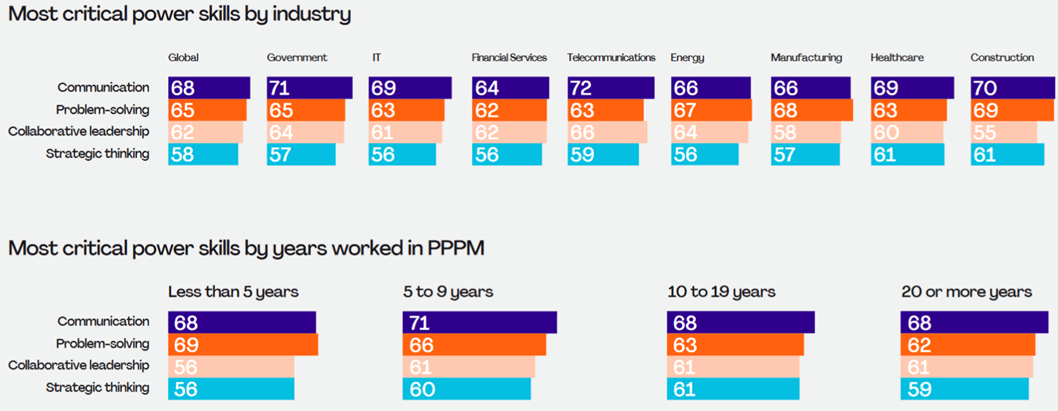
Another important issue is to make the knowledge existing in the company available to as many people as possible in a sustainable way (“if company X knew what company X knows”). If this works better, the knowledge will also have a positive impact on future project results.
This also includes the topic of sharing knowledge.
Knowledge Sharing Continues on the Rise
You will be a familiar with this problem: gurus as a single source keeping their important knowledge to themselves create bottlenecks in resource planning.
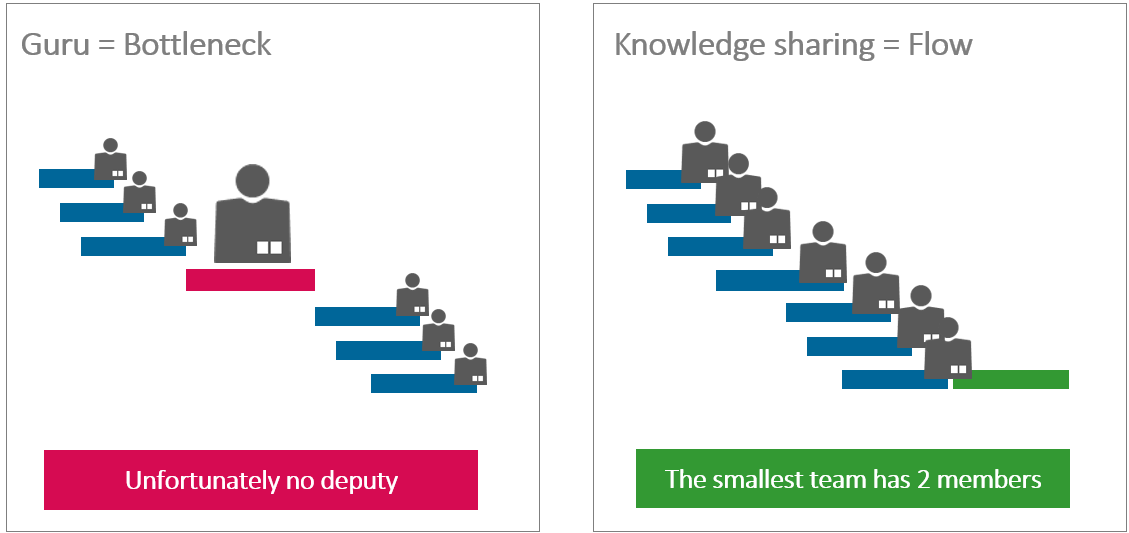
If you have too few suitable staff members with similar knowledge whom you can deploy at the same time, this will lead to resource conflicts. The closer the skills of the available staff members are to each other, the easier it will be to assign them. This will automatically reduce conflicts.
Yet, this will only work if you really share the knowledge. Hence, it is not the actual number of people that is the problem but the bottlenecks for certain skills.
You may be faster on your own in the short term. In the long term, however, you will get further together. In agile environments, this mindset is the norm. Yet, for many established traditional organizational structures, this kind of rethinking will be a major challenge.
The trend towards sharing knowledge is becoming more and more prevalent regardless of the industry. As a project management trend, it is increasingly exhibited by the younger generation.
Our tip: Support the different options to communicate (e.g., via chat) and try to make the knowledge you have gathered available for future projects (e.g., with AI tools). Plus, ensure that the knowledge of key experts is distributed among several heads.
Trend 4: Greater Focus on the Benefits of Results
Today, it is not enough that something is meant to be done. Increasingly, we ask about the how and the why. The outcome of a project and the way there must meet the requirements of environmental protection and ESG criteria. Employees are increasingly interested in this, as are the company’s customers and society as a whole.
Projects in the area of organization and software are subject to rapidly changing environments and have to be guided even more by the intended benefits, which can change even during the project’s lifetime.
Since 2023, we have observed that companies implement more and more ESG-related projects. On the other hand, there is a trend towards major projects, particularly in the areas of infrastructure, energy supply and defense.
A poll in our 1/2024 webinar showed that only a quarter of the participants had defined ESG guidelines while ESG was not a factor for two thirds.
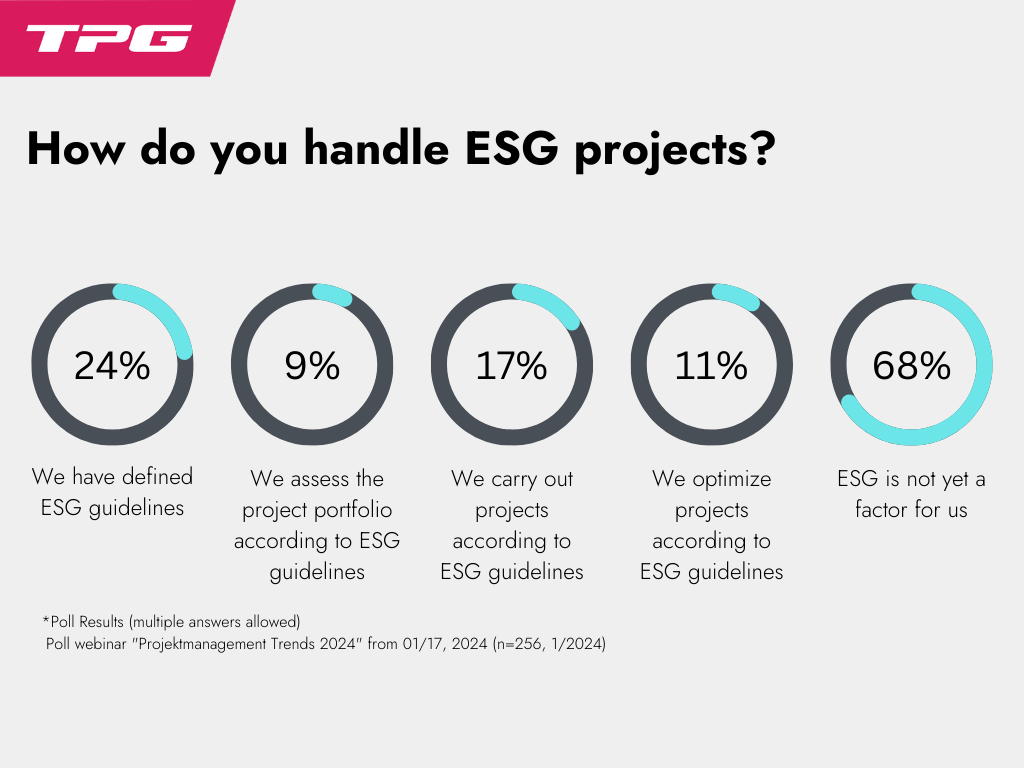
Missing targets is becoming increasingly difficult to afford. Hence, your portfolio should be increasingly focused on the actual benefits of the results of your projects. Once the intended benefits of a project can no longer be achieved, a project abort is a good decision. This is particularly important in an environment of scarce resources.
Our tip: Consider how to implement three-part project planning with a focus on the project benefits (e.g. in portfolio management). A suggestion would be:
- Description of the goals and the benefits
- Roadmap with phases, milestones and deliverables for the recipients of the service
- Internal detailed planning with the activities for achieving the deliverables for (increasingly self-organized) teams
Trend 5: Change Management and Transparency Are Becoming More Important
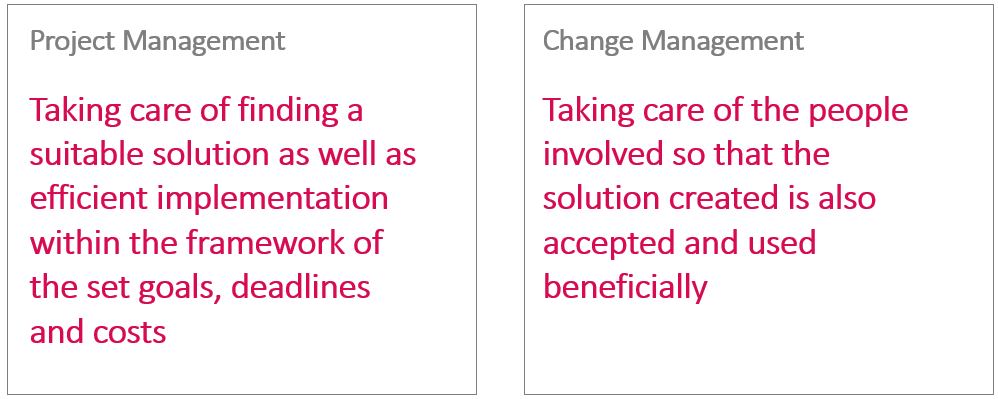
In the context of digitization, organizational changes are often implemented as projects. In this process, something often goes wrong. Implementing a new software tool, for example, may not bring the desired benefits, as the prospective users have not been duly accommodated, prepared or taken along.
To make projects successful, it is indispensable to duly address the change process in the organization in parallel to the actual content implementation. This is the task of change management in projects.

It will depend on the scope of the changes and the number of people affected whether taking care of the change will be a task for the project manager. However, it probably always makes sense in such ventures to get change management specialists on board.
This insight may not be new. Still, lately people have not only talked about it but acted on it. Change management is a key success factor for projects in the future.
Greater Transparency Now Supported
This includes a growing readiness for greater transparency in the project environment: red traffic lights are now often deliberately set as an early-warning system and are no longer a no-go as they used to be. The former habit of ducking away in difficult situations continues to subside. More and more people point to deficiencies and want to contribute to changing things.
A poll in our 1/2024 webinar revealed that a third of the participants still saw no real response to resistance to changes – a deplorable number with a lot of potential for the companies affected. The same result applied to assessing the effectiveness of trainings. At least, a majority regarded training (60%) and sponsors (59%) as necessary in the context of changes. Surprisingly, the results have hardly changed since the same poll in the webinar a year earlier.

Our tip: In change projects, ensure from the beginning that the people affected by the changes are properly prepared and also assisted.
Read more here: Change Management in Projects for Project Managers
Trend 6: Resource Planning Is Becoming More and More Important
The recent studies and surveys have clearly shown that project resource management is becoming more and more important. This is commonly considered the “most difficult area of project management. That is why many companies have not addressed it so far.
In actual fact, getting started with successful resource management is not that hard. What matters, however, is the right approach, starting with rough planning, and that all activities of the resources are tracked completely. Only then can resource planning work properly in the team, project and company at portfolio level.
Besides, all roles must be involved.
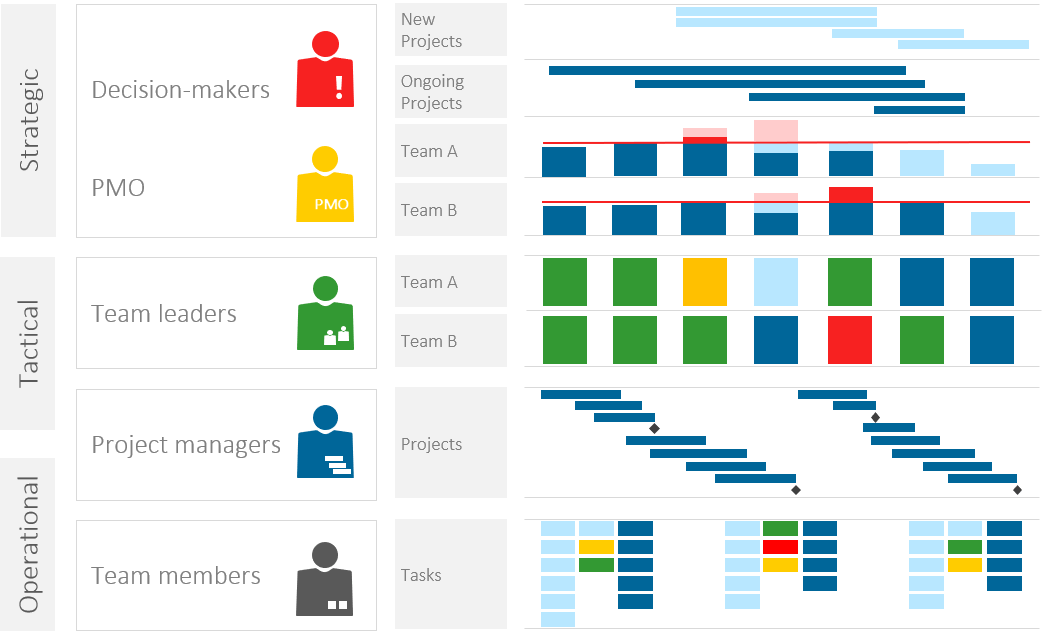
Project Management Office (PMO)
Thus, the PMO for example is increasingly taking on the coordination of resource management alongside team leaders and project managers. Together with the decision-makers, this central office has to provide capacities with the appropriate skills in a forward-looking manner.
Team Leaders
The team leaders are increasingly involved in ensuring their team members receive ongoing training. For example, retraining personnel is one way of continuously increasing knowledge. The goal should be to retain employees in the long term. Expanding their knowledge will not only strengthen the staff’s ties to the company but will also provide for employee satisfaction. After all, satisfaction with one’s own job is becoming more and more important in the fast-moving labor market.
Project Managers
Project managers are increasingly engaged in finding solutions for clear goals and social skills. Traditionally, it used to be possible to define a clear goal with the project order. These days, however, we are often unable to fully define this, which makes a different approach to the topic necessary. In addition, the constantly growing number of projects means that the responsibility of the project managers to adequately take care of everything has increased.
Team Members
Mastering all of this, requires team members to deal honestly with ambiguity, lack of knowledge, and deadlines (see also VUCA in Project Management). After all, the main reason for unsuccessful projects is missing goals or failure to define them clearly.
Our tip: Good resource management will only work together – in the interaction between project manager, team leader, team member and PMO. Lay the foundations with processes and tools.
The resource planning processes must ensure the involvement of the team leaders in the coordination process between project and line management. Only by looking at both perspectives, will you obtain complete and therefore reliable resource planning.
To make matters worse, new requirements for further projects and future fields of knowledge come up at ever-shorter intervals. These have to be taken into account more flexibly in strategic capacity planning.
Reading tip: 6 Steps to Resource Management – Implementing Tactical Planning
For this reason, PMO and portfolio managers require even better support in variable scenario planning. In accordance with the priorities and availabilities of the coming months and years, they have to decide which new projects to start, and when. Some also have to be very flexible in postponing projects and bowing to the new external circumstances.
Rough yet complete resource planning is more helpful for this purpose than precise planning for only a few projects. There is growing acceptance of the “Complete and good enough” approach. What is more, companies are increasingly turning away from Excel in the resource management context, as the tool is just not flexible enough. Special tools for resource management are much better suited to this.
Special Download: Resource Planning Software for the Roles Involved (PDF file)
Please fill in the form.
* Required Fields | Data Protection
Our tip: Rough and complete resource planning (all operations, absences and project activities) is better than planning a few projects in detail while being incomplete overall.

Social and Soft Skills for the Project Management of the Future
If you are working in the project environment, you should consider a few pointers concerning social and soft skills. They will help you be all set for the future trends in the ever more complex project environment and increasingly challenging resource management:
- See the people, not things, behind the term ‘resources’
- Encourage creativity in finding solutions
- Allow for failed attempts and factor them in
- Create trust as the basis for honest appraisal of the circumstances and tasks
- Provide for less stress in projects caused by uncertainties (I’m not at home in the subject, we won’t finish, etc.)
- Create an environment in which teams feel comfortable and do not want to run away
- Overall, there is a trend requiring project managers to become (like) team leaders – “You can manage things, but you have to lead people.” And why is that so? From the company’s perspective, this is the guiding principle which will be perceived as increasingly true as skilled labor becomes scarcer: “The most important things are no things.”
A poll on the resource situation in the 1/2024 TPG webinar confirmed the importance of pain points in resource management: problems with processes, staff, skills and tools are common.

Trend 7: The PMO Is Becoming More Strategic
The PMO is increasingly taking on responsibility for the implementation of strategic targets. Organizationally, it is most beneficial if the PMO is established as an executive department with direct access to top management.
In this context, successful strategic capacity planning requires an enterprise-wide resource overview and good skills management. Finding and training appropriate resources is essential, as is their even more dynamic assignment to strategically valued projects.

In portfolio management, the PMO should work more towards the abort of weaker projects in the future. A purposeful project abort will free staff members on time for projects with a higher priority.
The term “fail cheap” is not new, yet it is particularly important in this context. It makes sense to recognize failure early and take appropriate action before the damage becomes even greater. This supports the cultural change needed in the future towards successful project failure.
Our tip: Ensure from the top down that failed projects can be recognized as such and aborted. This requires a cultural change throughout the company that takes away the project managers’ fear of failure.
Special Download: 10 Vital PMO Success Factors (PDF file)
Please fill in the form.
* Required Fields | Data Protection
Another poll in our 1/2024 webinar regarding the desired future PMO functions arrived at the results shown in the graphic below:
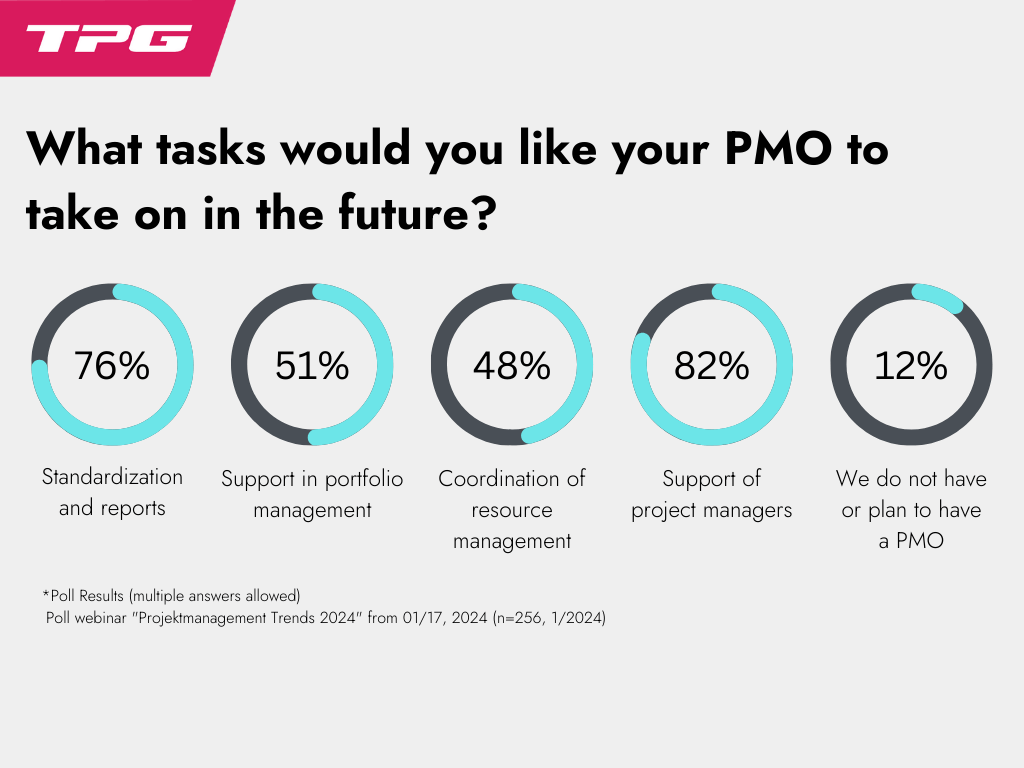
The respondents rated the support of the project managers highest, followed by standardization and reports, support in portfolio management and the coordination of resource management. Three of four responsibilities were desired by over 50% of the 256 webinar participants.
In the future, PMOs must brace themselves for the following changes:
- Stronger ties to the boardroom / top management
- Not only creating standards and reports
- More coordination in resource management
- Stronger involvement in portfolio management
- Flexible use of PM methods
- Individual guidance and support for project managers in traditional, agile or hybrid processes and methods for the right mix
- Lessons Learned are to be applied and ongoing adjustments to be made to the PM Guide
Conclusion: Project Management Trends
In this article, you have learned which project management trends are foreseeable from our point of view. We have placed particular emphasis on the areas of resource planning, collaboration, roles, methods and tools.
In conclusion, we present all project management trends at a glance:
- Some relevant studies
- Trend 1: More artificial intelligence in project management
- Trend 2: PM tools and automated data use
- Trend 3: Communication is increasingly integrated into project plans
- Trend 4: Greater focus on the benefits of the results
- Trend 5: Change management and transparency are becoming more important
- Trend 6: Resource planning is becoming more and more important
- Trend 7: The PMO is becoming more strategic
Our final tips:
Get to know the individually adaptable “PPM Paradise” – the optimal environment for your enterprise-wide project, program, portfolio and resource management (PPM). Download the free eBook “The PPM Paradise” now (just click, no form).
And sign up for our bi-weekly blog newsletter with information on more hands-on articles, eBooks, etc. to improve your project management maturity level.
Do you see other project management trends which you would like to add? We look forward to receiving your feedback. Thank you.
Subscribe to TPG BlogInfo: Never miss new practice-oriented tips & tricks
Every other week: Receive practical tips in TPG blog posts written by recognized experts in project, portfolio, and resource management.
* Required Fields | Data Protection
Johann Strasser
Managing partner at TPG The Project Group
The certified engineer, has been a managing partner at TPG The Project Group since 2001. After many years as a development engineer in the automotive and energy sectors, Johann Strasser spent a decade as an independent trainer and consultant in the field of project management. During his tenure, he also served as project manager for software projects in the construction industry and provided scheduling and cost management support for large-scale construction projects. At TPG, he applies his expertise in product development and consulting services for international clients. His special focus is on PMO, project portfolios, hybrid project management, and resource management. For many years now, he has shared his knowledge through presentations, seminars, articles, and webinars.
You can read more about Johann Strasser on LinkedIn and XING.
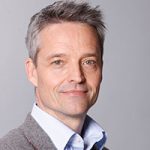 Achim Schmidt-Sibeth
Achim Schmidt-Sibeth
Senior Marketing Manager
After earning his engineering degree in environmental technology, he gained many years of experience in project management through his work at an engineering office, an equipment manufacturer, and a multimedia agency. Achim Schmidt-Sibeth and his team have been responsible for content marketing and communication at TPG The Project Group for many years now.


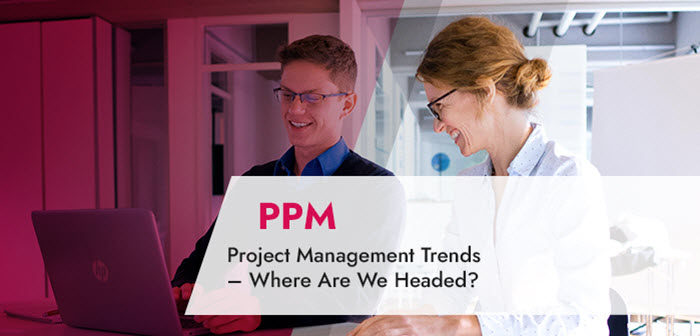







15 Comments
Great article!
Thanks, Pieter. Glad you appreciate it!
This article sums up so many trials and tribulations with what my team is trying to plan in our organization but the balance of organizational openness to change and the right subject matter experts in the mix of tools makes the goal almost seem unobtainable
Thank you very much for sharing the above article. In my opinion as a PM, 3) Cross-Company Projects Favor Cloud Solutions; 4) Traditional and Agile Tools Are Best Used in Parallel; and 5) More Customer Projects with Agile Implementation are the most important and common trends in 2019 and beyond.
Thanks for your valuable feedback, Cathy!
Interesting article! The last point had made me recollect one more perspective b/w settlers and new comers to a project.
Thanks Alim, glad you liked the article! yes I think we tend to forget in our attempt to optimize and find new ways – that we might profit even more if we take a hybrid approach and profit from 2 point of views instead of just one.
In my opinion:
Trend 1) Complete resource plans wanted – Very good input
Trend 2) Sharing Knowledge Will Take You Further – Necessary
Trend 3) Fixed teams deliver better results – Absolutely necessary
Trend 4) Cross-Company Projects Favor Cloud Solutions – Yes, when it is possible
Trend 5) More Customer Projects with Agile Implementation – May be
Trend 6) Traditional and agile tools are best used together – Yes, I already did it and was a very good solution
Trend 7) Open-ended results deliver greater benefits – Not always
Trend 8) Project managers, as communication experts, are accountable for the benefit – Necessary most of the times
Trend 9) Change management concurrent to project management – Necessary
Trend 10) PMO bears greater responsibility – Yes, good input
Trend 11) Cultural change towards accepting successful failure – Necessary
Trend 12) Change is acceptable if you understand why it’s needed – Why, when and how
Very good article
Thank you for your ranking Manuel 🙂
thank you
Very good article, Trend 1 is really the top concern now.
My only comment would be related to Trend 8) Project Managers Are Accountable for More Than the Result only. Why?
Usually, the Project Manager “PM” hands-over the result to a responsible business person at project buyer organization – because PM is usually needed for the next project. There are responsibilities of:
– the responsible business person and
– PMO (or, project portfolio management unit).
The responsible business person (in optimal situation) had initiated originally the project idea to get it approved as project for realization and should work with the project output, together with his/her colleagues further to bring the benefits of the project realized (e.g., better product competitiveness via value-added features in service-oriented industries). So, the responsible business person should be accountable for bringing the benefits from the investment / the project realized.
PMO should be responsible for the definition of data needed (together with the responsible business person) before the project justification and approval – and also for checking the situation after the project end to get the required data for the benefits evaluation, This evaluation should be submitted to the same Committee which had approved the project. In optimal situation, the benefits realization should be tied to certain part of annual bonus of the responsible business person.
Above process would be sign of high PM & PPM maturity level. In reality, at least from my experience, there has been always fierce opposition of responsible business persons to get accounted for the projected benefits / results, drafted by themselves in competition with other project proposals to get their proposal to be realized as project (in other words, most of them inflated expected benefits a lot ;-). From outside it seems that Google has mastered above process – so no wonder they are so successful.
Very good article
Thanks, happy to hear that!
Thank you for an insightful and interesting article. It will certainly give me and my students some points of discussion in the coming months. Thank you!
Great to hear that, Andre Knipe! Thank you!